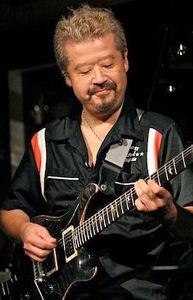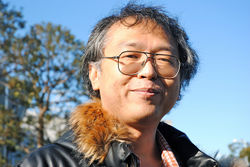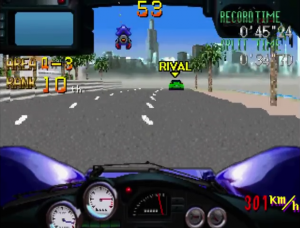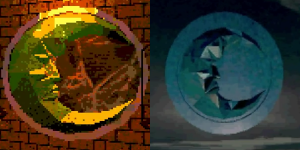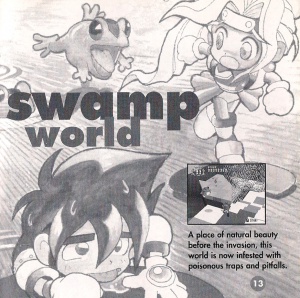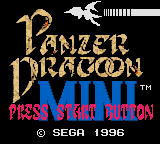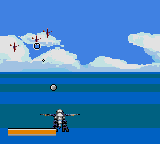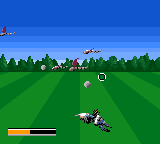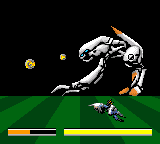Blog:14
Burning Fists: Force Striker (Mega CD/Sega CD)
CRV (talk) 06:10, 22 June 2017 (CEST) [permalink]
Street Fighter II was such a phenomenon, even Sega of Japan made tepid attempts at cashing in. There was the arcade game Burning Rival, which is neither well-liked nor well-remembered. On the Master System and Game Gear, there was Masters of Combat/Buster Fight (developed by SIMS), which had a Dhalsim-like character with stretching arms and legs. Then there's this unreleased Mega CD/Sega CD game from 1994.
Burning Fists received little press and was quietly cancelled. Nevertheless, it was supposedly 80% complete, and there were two protoypes that eventually fell into the hands of Good Deal Games, which polished them up for a 2006 release.
So what do you get at 80% complete? Well, you get to choose from a motley but unmemorable cast of characters including a Japanese martial arts guy (the Ryu of the group), a Russian boxer with blue skin (the Blanka of the group, I guess), an overweight US Army guy, and a female wrestler.
The game itself, which is compatible with the six-button controller, is pretty unremarkable. You have various punches, kicks, and moves, you can block, and you can throw your opponent, but there's just nothing here that makes it stand out from other fighting games.
Most of the stages are fairly mundane as well, but a couple have nice flourishes. For example, the Daytona stage has a race car in the background that speeds off when the match is finished. A couple of the locales are interesting; I can't think of too many fighting games with an Iraq stage.
The AI was apparently beefed up for the GDG release, according to this article, but the notes on the disc say this was "canned." Either way, it's anemic most of the time. In many instances, you can spam a single attack.
What don't you get at 80% complete? Despite Good Deal Games' efforts, you don't get a bug-free game. On rare occasion, your opponent will stop moving.
And be careful not to press the start button after you win a round, or you'll activate a different bug — or perhaps it's a leftover debugging feature. The game will freeze, and you'll have to advance frames by pressing start until the word "FIGHT" forms in the next round.
One of the stages is missing: Denmark. There is no final boss battle, though you see his intro at the end of the game. You also don't get endings for each individual character; apparently these didn't work right and can't be seen in-game, but they are included as a bonus video on the disc.
There isn't even a consistent game name. The title screen says Force Striker, but other parts say Burning Fists, hence the conjoined name on the GDG release. According to Goodbye Soft, a book of unreleased MD/MCD/32X games, previous titles were Hustle Muscle and Real Fighters. (If you watch those individual endings, you'll see the characters all become "Real Fighters" after beating the boss.)
If you dig around the disc, you'll find the name of developer KAZe. Known more for pinball games like Last Gladiators on the Saturn, this would be KAZe's earliest known title for any Sega system. The company would not do another fighter until the Kamen Rider games for the PlayStation several years later. A 2ch post from 2007 backs up KAZe's involvement and says former Namco sound designer Norio Nakagata was the producer.
Speaking of sound, one of Burning Fists' strong points is the music, which seems like rejected tracks from Last Gladiators (not a bad thing). I went so far as to ask Last Gladiators composer and frequent KAZe collaborator Yusuke Takahama if he was involved; he confirmed it. ("Yes, I think I was in charge, but I do not know if the game was released.")
Overall, Burning Fists: Force Striker is a standard fighting game with glimmers of potential. It would have been decent if it was finished, but it probably would have never been a big hit.
The following video is a complete playthrough which also highlights some of Burning Fists' bugs and missing/incomplete features.
{{#ev:youtube|cv2bvT2AWqM}}
Virtua Fighter 2 (Genesis/Mega Drive)
CRV (talk) 23:56, 30 May 2017 (CEST) [permalink]
Running on Sega's top-of-the-line Model 2 hardware, Virtua Fighter 2 was a remarkable feat of graphics and gameplay when it was released in arcades. Even the Saturn version seemed incredible at the time, but it took a lot of work to get it running at a high frame rate, and it was still not arcade perfect. Surely bringing VF2 to the Genesis would be an impossible task. That didn't stop them from trying.
Unsurprisingly, the graphics are the greatest and most obvious difference in this 16-bit version, now entirely 2D. The character animation is a little choppy, but the effect on gameplay is minimal. It still controls like you would expect a Virtua Fighter game to control.
The music has been competently converted, marred only by the overall tinniness of the audio. The voice samples, meanwhile, bring back memories of Fighters Megamix on the game.com. On second thought, they're not quite that bad, but they are scratchy.
Invariably in such translations, some content is going to get cut. Gone are the new characters from the arcade version, Shun Di and Lion, and some of the backgrounds. Some voices and moves are also missing.
It would be easy to dismiss this game as shovelware; however, consider that it was put together by a fairly extensive team in Japan (the only place where this version wasn't originally released). The programming and some of the graphics were done by Gai Brain, which developed a number of Takara's SNK ports including the great Game Gear version of Fatal Fury Special. Cotton maker Success was also involved with the graphics. Data East was involved in a production and direction capacity. Prolific audio company Cube worked on the sound.
Even Satoshi Nakai, who designed the enemies in Wings of Wor and Resident Evil – Code: Veronica among many other things, toiled away on this game. As he said in The Untold History of Japanese Game Developers Volume 2, "I have painful memories of banging out pixels while drenched with sweat from the hot summer weather." And he just worked on Jacky.
On its own, Virtua Fighter 2 is not bad; you couldn't expect much better on the Genesis. It's just not better than any other version and was/is completely unnecessary. It's a novelty — a novelty they insist on including in every Genesis compilation and plug & play device ever made.
{{#ev:youtube|P1EsVwHdndQ}} Video by "AoFparson" on YouTube
Transformers: Mystery of Developer
CRV (talk) 05:49, 1 December 2016 (CET) [permalink]
The Transformers game Convoy no Nazo, or Mystery of Convoy, is one of the most high-profile examples of "kusoge" on the Famicom due to its high difficulty and other gameplay quirks. The mystery is supposed to be what happened to Optimus Prime, but the bigger mystery, and the one that remains unsolved, is who developed this infamous game. Unfortunately, there's some conflicting information:
- The company ISCO (pronounced as one word [isuko]) listed the game on its website [1], but could they have been referring to the Famicom Disk System game Transformers: The Headmasters? Note the similarities between it and the ISCO-planned Paris-Dakar Rally Special in these videos: [2] [3]
- Convoy no Nazo popped up slightly in a Tose code comparison.
- In a post written after Convoy no Nazo's release on Wii Virtual Console in Japan, a former game graphic designer alleged that the president of Locomotive was the game's programmer. Tose and Locomotive were based in Kyoto, so it's not inconceivable that he worked for Tose before starting Locomotive. (The sound designer on StarTropics allegedly once worked part-time at Tose. The US copyright registration for StarTropics credits Locomotive with music, so we can infer that said designer later worked for Locomotive.)
- A former Advance Communication employee rattled off "FC Transformers" in a tweet about the company, but neither Transformers game seems like an Advance Communication game, and Convoy no Nazo predates any of their other games.
{{#ev:youtube|uWjmkk5H9PE}}
Video/World of Longplays
Post updated November 30, 2018
Sounders: Natsume (Where Are They Now)
CRV (talk) 05:07, 11 August 2016 (CEST) [permalink]
In the first edition of a new feature chronicling sound designers and production companies, GDRI catches up with some of the sound designers from Natsume (now Natsume Atari)'s 8/16-bit golden age.
|
Kiyohiro Sada worked at Konami from 1986 to 1989, where he worked on many Famicom and NES games like Contra and The Adventures of Bayou Billy. He joined Natsume in 1988 and continued to work for Konami. He became a full-time employee at Natsume the following year. Sada's best-known works with Natsume, at least outside Japan, are probably Abadox and S.C.A.T. Abadox seemed particularly influenced by his former employer's Life Force, and Sada's distinctive sound no doubt helped it feel that way. Sada left in 1993 and formed his own sound production company called Pure Sound, which he still operates today. Pure Sound has worked on many games over the years including the Summon Knight series, Half-Minute Hero, Robo Pit, and The Legend of Zelda: Oracle of Ages.
|
|
Iku Mizutani also came over from Konami (MSX Metal Gear, NES Rush'n Attack). His first game at Natsume was the NES conversion of Heroes of the Lance. He continued to work on many more games across many platforms including Shatterhand, SNES Power Rangers, and Mobile Suit Gundam Seed: Battle Assault. In 2006, Mizutani started Sound Fountain, which worked on The King Of Fighters XIII, DS/3DS Medarot games, and various games by Osaka Natsume offshoot Bullets.
|
|
Hiroyuki Iwatsuki joined Natsume in 1990 and is still with Natsume Atari today, working at the Nagoya office. His titles include fan favorites like Wild Guns, Pocky & Rocky, and SNES Ninja Warriors, as well as more recent titles like Omega Five and Wild Guns: Reloaded.
|
|
Kinuyo Yamashita is yet another musician who left Konami (Castlevania, Nemesis 3, Arumana no Kiseki). The difference is, Yamashita was never a Natsume employee; she has worked mostly as a contractor since exiting Konami. Her profile is also quite extensive. Among the titles on which she was involved are GBC Croc 2, SNES Power Rangers, Pocky & Rocky 2, and Mark Davis' The Fishing Master. A subarachnoid hemorrhage sidelined Yamashita in 1998. She eventually recovered, however, and continued to make music. She now lives in New Jersey.
|
| ????
Shinya Kurahashi (倉橋真也) (Shimono Masaki no Fishing to Bassing, Zen-Nippon Pro Wres: Fight da Pon!) was with Natsume's Osaka division for a while, but little is known about him. Not much is known about Kouichi Yamanishi (山西浩一)(Dragon Fighter, Shadow of the Ninja), either. |
Credit to the creators/uploaders of the videos above. Photos sourced from Videogame Music Preservation Foundation Wiki.
Gale Racer (Saturn)
CRV (talk) 05:33, 3 August 2016 (CEST) [permalink]
The first game released for Sega's System 32 arcade hardware, Rad Mobile was impressive when it came out back in 1991. Three years would pass before there was a home system powerful enough to contain it. Enter Gale Racer for the Saturn.
The object, like the arcade game, is to drive from Los Angeles to New York and claw your way to first place. But does this Saturn version perfectly replicate the arcade experience? Not quite.
While Rad Mobile moves seamlessly from locale to locale ala Out Run, Gale Racer pauses between stages to show you your time and load the next section. This really changes — some might even say ruins — the flow of the game.
Other vehicles on the road are made of polygons instead of sprites, which looks a little janky. The draw distance is lower, and the frame rate is not as smooth. The whole game seems a little buggy and a little glitchy.
Development of Gale Racer was handed off to System Sacom, which was known mostly for adventure games. Main programmer Hiroshi Ogino wrote an e-book about his time at the company, and he devoted an entire chapter to this game. Not surprisingly, porting it was quite difficult; the arcade cabinet and image/stage data were made available, but not the source code.
Sega of America was at one time planning a US version, as it was mentioned in a press release announcing the Saturn's early launch. GameFan reported that it would "be completely repaired to mimic the arcade game perfectly." When asked about it, Ogino seemed to have no recollection. [4]
{{#ev:youtube|Q1Db7NotLbs}}
Post updated September 4, 2020
Change of Heart: Secular Developers Turned Christian
CRV (talk) 05:36, 30 January 2016 (CET) [permalink]
A joke, circumstance, opportunity, a calling. Whatever the reason, some secular developers switched to, or at least tried their hand at, making Bible-based video games.
Wisdom Tree
The most well-known example grew out of Color Dreams, a publisher and developer of unlicensed games for the Nintendo Entertainment System. Color Dreams founder Dan Lawton allegedly came up with the idea of doing religious games as a joke.
Early on, Wisdom Tree took the older, more violent Color Dreams games and inserted family-friendly, Bible-related content. Sunday Funday: The Ride (NES) is basically a hack of Menace Beach, while Exodus: Journey to the Promised Land and Joshua & the Battle of Jericho (NES, et al.) were based on Crystal Mines. Since then, Wisdom Tree has put out a number of original educational and entertainment titles and continues to sell them on its website. Color Dreams is still around, doing business as StarDot Technologies, making surveillance cameras and related equipment.
See also:
{{#ev:youtube|9vzSAFayegI}}
{{#ev:youtube|0SjOvOUXn9A}}
Credit to the creators/uploaders of the videos above
Japanese-Developed Digitized Fighting Games
CRV (talk) 00:58, 24 December 2015 (CET) [permalink]
The success of Midway's arcade blockbuster Mortal Kombat birthed many imitators. Would you believe some of them came from Japan?
Reikai Doushi (1988, Arcade)
While Mortal Kombat was the breakthrough hit that influenced a lot of games, it was not the originator of the digitized fighting form. Neither was Pit-Fighter. No, that honor goes to this little number by Home Data (now Magical) featuring a colorful cast of grotesque Chinese puppets.
{{#ev:youtube|ifBJbECq3yE}}
Floating Runner (PlayStation)
CRV (talk) 23:11, 5 September 2015 (CET) [permalink]
Hey, it's a 3D platformer that came out before Super Mario 64 and before analog control was standard on consoles. That's pretty cool, right? Right?
In Floating Runner, you lead either adorable bounty hunter Lay or adorable priestess Cress on a journey to find seven crystals to save Crystal Land. Adorable enemies will try to stop you, but you can stop them with your adorable weapons.
As adorable as everything is, there are problems, and you can't blame them all on age. Some make the game unnecessarily frustrating to play at times and could have been avoided. Let's run down the list:
- 1) Your default weapon shoots in an arc. There are other weapons, but you have to find them scattered throughout the different worlds.
- 2) The enemies are way too fidgety.
- 3) Stage layouts can be disorienting. The lack of camera controls doesn't help. (You can only switch between two angles.)
- 4) Controls are slippery, making jumping on platforms tricky.
- 5) There aren't too many health potions around. (Yet the first stage has five!)
Better weapons and less ponderous stage layouts would have gone a long way in making a better game, but it's not all bad. The frame rate is brisk. The music is pleasant (though sometimes repetitive), as is the mix of flat-shaded and texture-mapped polygons. It's still a charming game.
For many years, it was a mystery who developed this pioneer software. There are no ending credits. Xing is the only Japanese company name that appears in-game or on the game, but they were just a publisher.
Modern technology allows us to look inside the data and find an unused T&E Soft copyright notice and list of credits. It's not clear if they were supposed to be displayed on-screen. It's bizarre that a company like T&E Soft would make a game like this and leave their name off.
Hydlide creator Tokihiro Naito talked very briefly about Floating Runner during his interview in The Untold History of Japanese Game Developers Volume 2. He didn't know anything about it, unfortunately; he was about to leave T&E Soft and had little interest in their in-house games. He said it may have been developed by the Osaka branch. A check of the names suggests that is the case. (T&E Soft's Osaka branch [formerly Xtalsoft] is where games like Red Alarm were also made.)
D4 Enterprise, the company behind the Project EGG service, acquired the rights to T&E Soft's back catalog in 2019. Floating Runner can be found in their list of properties.
{{#ev:youtube|0lLAzt6LXyI}}
Post updated January 31, 2020
Panzer Dragoon Mini (Game Gear)
CRV (talk) 16:35, 24 June 2015 (CEST) [permalink]
Towards the end of the Game Gear's life in Japan, Sega rebranded it the Kid's Gear in an attempt to market the system to children. One of the handful of titles released under this brand was Panzer Dragoon Mini, but there's nothing particularly cute about it. This is just Panzer Dragoon, stripped to the bare bones.
After you choose one of three dragons to control (not ride, apparently), it's on to the action. You make your way through several stages, shooting down enemies with either your regular shot or a lock-on laser. (There's no berserk attack despite the game coming out after Zwei.) Sometimes the camera shifts to the side, but that's about as exciting as it gets. (Even the R-Zone version had camera control.) There are mid-bosses and end bosses, but their attack patterns consist primarily of moving back and forth spraying bullets.
The backgrounds and especially the sprites look nice. The music is pleasant as well; whoever did these arrangements should be commended. (Hitoshi Sakimoto's works list says he only programmed the sound driver.) It's just a shame the game isn't better.
That's a tough thing to say, because it was clearly made by capable people. (My guess is the development period was very short.) All the evidence here points to Rit's as the developer; Rit's also made some original RPGs, most notably the Dragon Master Silk series, and worked on many of the old Shining games. In addition, the president of the company — the artist known professionally as Hiroshi Kajiyama (who passed away in 2018) — acknowledged working on the game on Twitter.
Some images from SMS Power!
Post updated March 11, 2020
Pinball Spirits (Windows)
CRV (talk) 04:48, 14 May 2015 (CEST) [permalink]
I like me some video pinball; I've amassed a decent collection of video pinball games. So when I found out about a pinball game that involved GDRI veteran Opera House and only came out in Japan, I was interested. Actually, even if it isn't great, I want it.
But good luck finding it - not only is Pinball Spirits a Japanese exclusive, it's available only for Windows. There's a copy on Amazon Japan for under $60 US. Enjoy the cover shots at the link because that's all you're gonna see.
Such is the world of Japanese Windows games. They seem to be among the most poorly documented and poorly preserved, unless there's something going on that I don't know about (which is possible). At least shopping sites like Amazon have games listed.
There's more than just eroge. Did you know Konami released games like Henry Explorers (Crypt Killer) for Windows in Japan?
Fun fact about Pinball Spirits: It was produced in cooperation with the non-profit Tokyo Pinball Organization. Read more about them here.



